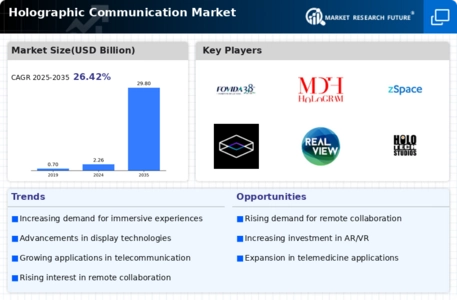Market Analysis
In-depth Analysis of Holographic Communication Market Industry Landscape
The Holographic Communication sector's market dynamics have been experiencing significant growth and transformation over recent years. Holography involves technologies enabling the transmission and display of three-dimensional images or movies live (in real-time) from a distance using light diffraction. The increased desire for comprehensive visual experiences in communications has become one of the main propellers behind this aspect within the realms of business entities. The fullness-of-life experience offered by traditional methods like video-conferencing cannot usually be compared to what holography holds when it comes to image depth. This allows individuals to talk without any limitations, regardless of their physical presence in the room, thus increasing engagement and fostering a better understanding. At the same time, the coronavirus pandemic is also causing changes in Holographic Communication's market dynamics. The growing restrictions on traveling and gathering have forced businesses to adopt virtual communication technologies extensively. Notably, technological advancements have had a significant impact on Holographic Communication's market dynamics over the years. With improvements in display technology, optical elements, and data transmission, holographic communication systems are now becoming more realistic (reality), scalable, and easier to access. In effect, portable holographic displays, cloud-based holographic communication platforms, and real-time rendering abilities for holograms have come about, thereby making it possible for various uses of holography to be practical and implementable. Moreover, augmented reality (AR) and virtual reality (VR) technologies have also affected the market dynamics of the Holographic Communication industry. Holographic communication is an advanced form of AR and VR that provides a more interactive and natural experience. However, there are some challenges in the market dynamics of the Holographic Communication industry. Infrastructure and network support are significant concerns in holographic communication. The transmission of large amounts of data needed for real-time rendering and display requires high-speed, low-latency networks for holographic communication to work properly. Another challenge is the expensive nature of holographic communications technology. High costs may be associated with developing and deploying holographic displays; cameras, along with related infrastructure and transmission, need specialized skill sets and resources.















Leave a Comment